“Get those vice grips of death away from me!” Cori said. I chuckled and replied, “Oh come on, they’re just harmless skinfold calipers for body fat testing. Pinch an inch, you know?” She continued to protest, “That’s the problem, I don’t have an inch, I have a handful! Yuck! Do we really have to do this?”
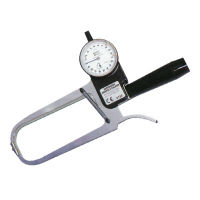
“Nope. You don’t have to do anything you don’t want to do” I assured her. “But listen – you signed up for this 12-week fat loss program, and you know from reading the Burn the Fat book how valuable body composition stats are for tracking your progress…”
“You should look forward to ‘pinch day’ because this is your motivation. This is your accountability. When you know we’re going to measure your body fat and weight every Monday, you’re going to work harder every week, I guarantee it.” Reluctantly, she agreed, “I know. You’re right. Ok, pinch away…”
If You Want To Improve It, Track It!
I’ve had many humorous conversations like I did with Cori over the years when I broke out the calipers to measure body fat percentage. With few exceptions, those chats usually ended the same way – no one ever denies the importance of tracking body composition instead of just body weight. They sometimes simply felt a little uncomfortable about someone grabbing their fat.
But after they started doing it, and they saw the results of accountability in action, they were sold!
The problem is, my time with a personal client comes to an end eventually and then they’re off on their own, free to continue measuring progress for accountability’s sake, or free to stop tracking. I believe that when people stop setting goals, and stop self-monitoring their activities and their progress toward those goals, that’s a big part of the reason why relapse rates are so high.
How can a 12-week coaching program or a 7-week body transformation contest produce such spectacular results, and the day it’s over, the results come to a screeching halt or even slip back in the exact opposite direction? Here’s one simple answer: You stopped doing what got you those results in the first place (no lifestyle change) and you let yourself off the hook (no accountability).
I understand that not everyone has the budget to work with a personal trainer or fitness coach forever. If you can, you’ve got the accountability times two, and I’d recommend you take advantage of it by asking your trainer to track your body fat at regular intervals. If you can’t, the good news is, you can coach yourself and test your own body fat, and you’re about to learn how.
The simple idea here is to measure and track everything you want to improve. If you want to improve your body composition and reduce body fat, then measure and track body composition and body fat. Tracking body weight is helpful, but doesn’t give the full picture – it doesn’t tell you what your weight consists of – muscle or fat.
There are many different ways to measure your body fat percentage. This post will be devoted to the skinfold method.
How Skinfold Testing Works
You store the majority of your fat, rather inconveniently, right on top of your muscles (obscuring the definition), and right below the skin. This is known as subcutaneous fat. You store fat internally as well, but since the majority of your fat is below your skin, you can use skinfold measurements to estimate your overall body fat percentage.
The test really is as simple as “pinch an inch.” All you need is a skinfold caliper, a vice-like device that pinches the skinfold and measures the thickness in millimeters.
After taking one or more measurements at various sites around the body, you can convert that sum of the skin folds into a body fat percentage using a math equation or an easy conversion chart that has already done the math for you. Some electronic calipers have the formulas built in, so they automatically display a body fat percentage right on the digital screen.
The purpose of this post is to show you some of the popular skinfold calipers, ranging from expensive professional models that are usually only used by trainers or health clubs, to super cheap plastic calipers that you can use at home.
Skinfold Calipers, Reviewed
There are more types of body fat calipers than I have time to review in this post, so what I’ll do instead is list the 5 calipers that I have personally used over the years, which also happen to be the most commonly used calipers. This way, I’ll be able to speak from experience.
I will also explain the pros and cons of specific calipers as well as pros and cons of skinfold testing technique in general – including addressing the common criticisms of body fat testing that lead some people to say, “don’t bother” (I disagree… but more on that later).
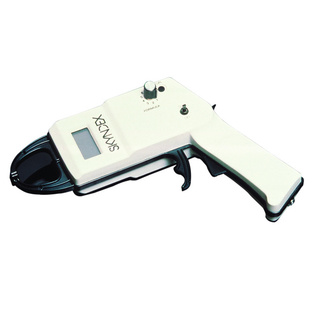
Skyndex Caliper
I was first introduced to the SKYNDEX caliper when I was working for Gold’s Gym in 1991. For professional use (as a trainer and fat loss coach), it’s my caliper of choice for testing other people.
The Skyndex is unique among calipers because it’s electronic. As you pinch the skinfold, you can see the thickness reading in millimeters on a digital readout. The precision is impressive – it measures the skin folds to the tenth of a millimeter (example 7.3 mm and so on).
Some argue that measuring skinfolds to the decimal point is moot, owing to the margin for error inherent in body fat testing. But personally, if a caliper offers that kind of precision, I like it, and I believe other experienced technicians will appreciate it too.
You can order the SKYNDEX with two different formulas for adults: The Durnin 4-site formula (bicep, triceps, iliac crest and subscaplular) or the Jackson Pollock 3-site formula (abdominal, thigh and pectoral for men or thigh, iliac and tricep for women).
Before another art aficionado gets confused or angry, let me assure you, Jackson and Pollock are a couple of researchers who published body fat equations in nutrition and exercise science journals in the late 70s and early 80’s. Jackson-Pollock is a different dude who artistically splattered paint on canvases.
I use the caliper with the Durnin formula. Usually, the Durnin formula is recommended for the general population, while the 3-site Jackson Pollock formula is recommended for lean, athletic types. This is just my opinion, but I find the Durnin skinfold sites much easier to pinch. The abdominal and especially the thigh skin folds can be tricky. On many people I have noticed that a nice skinfold cannot be easily pinched off the thigh, so I’ve always felt that I could get better accuracy and consistency with the Durnin skinfolds.
Whether I was testing a lean athlete or not with the Durnin formula never bothered me because body fat testing is more for charting progress from one reading to the next than it is for testing absolute accuracy. If you wanted the most accuracy in analyzing body fat tissue, you’d have to use the dissection method. Of course you have to be a cadaver for that…
If there is a downside to the Skyndex caliper, it’s the high cost. The retail price is around $500. If you shop around online however, you can usually find one priced under $400.
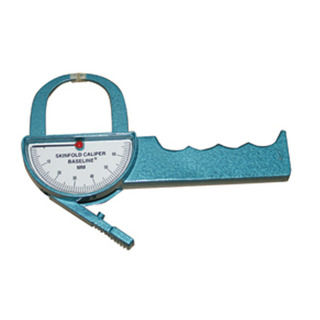
Lange Caliper
Known as “the green caliper,” almost every exercise science student and personal trainer certification candidate is familiar with this one. I used this one myself when I was taking exercise science classes in college, when
I took workshops for the American College of Sports Medicine certification and at various gyms I’ve worked at over the years.
This is another professional grade caliper that, if it’s not the gold standard, it’s certainly the most popular.
What makes a professional-grade caliper professional grade, aside from sturdy metal construction (as opposed to plastic), is the fine-tuned calibration and constant spring-loaded pressure of 10 gm/sq millimeter over the entire operating range.
The Lange skinfold caliper is not digital, it uses the traditional gauge readout, where a needle points to the millimeter reading on a scale.
This doesn’t make the Lange less accurate than a digital caliper like the Skyndex, it simply means there are two steps to take before you know your body fat. Step one is taking the skinfold measurements. Step two is adding up the sum of the skinfolds and looking it up on a conversion chart to find the body fat reading. The Skyndex does the conversion for you.
The caliper jaws open to 60 millimeters, so if you have a handful and not an inch, not to worry, you’ve covered! (if your skinfolds are in that range, however, you’ve got work to do!) Price: $225-$250
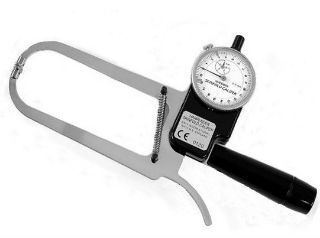
Harpenden caliper
Harpenden is not just a town in England, it’s also a skinfold caliper that has been used since the 1950’s.
The Harpenden caliper works almost the same way as a Lange, it simply has a different design. You could say it’s a competitor (or alternative) to the Lange caliper.
Some health and fitness researchers and practitioners call this the gold standard caliper or at least the most prestigious.
Studies have compared the Lange and Harpenden calipers and found the results were similar, both calipers being able to accurately measure body fat without error due to caliper design.
Researchers have noted in these comparison studies that both the Lange and Harpenden tended to underpredict body fat when compared to Hydrostatic weighing.
As a pro-grade caliper, this one has a hefty price tag considering there’s no computer in it. It retails for around $400.
I have to admit, these do look a bit like “vice grips of death.” But I promise, the pinch doesn’t hurt (unless of course you went overboard on that deep dish pizza and it’s sticking to your hip bone on fat testing day… then hearing the news about your test results might be “painful”).
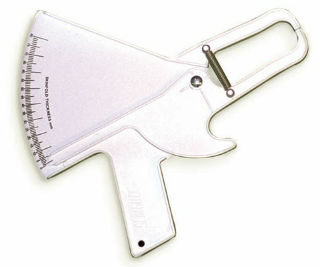
The Slimguide
Now we’re getting into the consumer-grade calipers and the price difference is so drastic, you’ll see why these calipers are called “consumer grade.” The Slimguide is a bargain for $20 retail, and if you shop around you can find it even cheaper.
Construction is one reason for the bargain price – this caliper is made out of all plastic with a metal spring for the proper caliper grip tension.
Years ago, I did my own little “study’ and I tested a few subjects with the Skyndex, Lange and Slimguide calipers back to back. I found the measurements provided by this caliper astonishingly consistent with the much pricier Skyndex or the Lange calipers.
Even if the results aren’t as high in absolute accuracy, as long as you can continue to get consistent measurements from week to week, that’s what matters most and these calipers do a fine job at that.
These calipers are ideal for personal use if you are testing other people at multiple skinfold sites (such as with the Jackson Pollock or Durnin Formula) or if someone else will be testing you at home.
[Available at Amazon.com: www.amazon.com/Creative-Health-6575XXXX-Skinfold-Caliper/dp/B000NN9SDO/]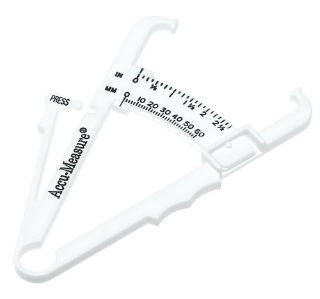
Accu-Measure 3000
So far you’ve heard about calipers that are designed for use by fitness professionals or which at least require another person to measure you (as in the case of the Slimguide).
Just to be clear, it’s possible to measure your own abdominal, iliac, bicep and thigh skin fold, but it’s ideal to have someone else measure at those sites for you.
When you get to a skinfold like the tricep, it really gets hard to pinch yourself accurately. And for the subscapular skin fold, which is on the upper back at the lower border of your scapula, you can’t measure that one at all, unless you are some kind of human pretzel (even then, not so accurate).
What I’m saying is that until the Accu measure caliper came along, skin fold testing was a two-person project. The Accumeasure changed all that. This is an inexpensive caliper not only created for consumer use, it was specifically designed for self-testing at home.
I was only partially joking earlier about the funny conversations I’ve had over body fat testing. Some clients are like, “No way in hell are you groping at my fat folds!” After explaining that it was not me – it was another famous bodybuilder known for groping – I then tried my persuasive speech about accountability, motivation, fat versus muscle, etc, etc, etc, all to no avail.
Fortunately, I suggested an alternative: Get a caliper so you can test yourself at home. Enter the Accu-Meausure. No second person (“fat groper?”) is needed.
The Accu-Measure is a one-site skinfold test – the only place you pinch is on your iliac crest (above your hip bone) which you can easily reach by yourself. Unlike other calipers which use spring tension, the Accu-Measure uses a slide rule, which clicks into place when the caliper jaws have settled onto the skinfold.
Like all body fat testing methods, this one is not without cons along with the pros. When you test body fat at only one site on the body, it’s possible you may be losing fat more rapidly at other sites, so you might show less progress than you’re really making.
One thing I’ve noticed among very lean athletes and bodybuilders is that the illiac crest, where you do the Accu-measure pinch, can also get very very lean (down to 2-3 mm) while other sites like the abdominal or upper back skinfolds are still rather large. So for very lean individuals, there comes a point when Accu-measure may lose some of its usefulness and a multi-site test providing more data points (more skinfold sites) gives you better information.
Some people also wonder if a little plastic gizmo like this could really be accurate. It’s possible the margin for error is higher when you’re testing yourself instead of having a pro test you, but practice makes perfect. In addition, a study published in the Journal of Strength and Conditioning Research found the Accu-Measure results comparable to the sum of three skinfolds taken by a professional grade caliper by an experienced tester.
All things considered, especially convenience (self-testing at home) and economy (retail is $20 or less), you can’t beat it. [Accu-Measure Site]
Why it’s worth the trouble to test and track your body fat percentage
Surprisingly, it’s not uncommon for some fitness professionals to say, “don’t bother” with body fat testing (or for practitioners to give up on it). This is for a variety of reasons, the biggest one usually being concerns about accuracy and consistency. It’s very true that skinfold testing is only accurate within a few percent and operator error can decrease the accuracy even more.
The good news is that accuracy is not nearly as important as consistency over repeated measurements so you can chart your progress over time. If you find a skilled tester, you’re likely to get reasonably accurate and very consistent measurements, and with practice, you can master the self-pinching technique if you’re testing yourself at home. Standardized procedures must be followed every time if you want consistent readings.
Some people argue that body fat testing is simply not necessary because, while progress should be monitored, it’s not mandatory to do so with body fat calipers. This is also true. At the very least, if you monitor 1. your appearance in the mirror (or with photos) 2. your total body weight and 3. your waist measurement, 4. your performance in the gym that’s better than no self-monitoring at all. Waist circumference is a good proxy for body fat because that measurement correlates well with body fat, and if you’re getting fitter and stronger in your workouts, the odds are high that your body composition will be improving.
The most important thing of all is not to get the most accurate measurement or to chase any “holy grail” body fat percentage number, but to keep body composition in your consciousness instead of obsessing about scale weight alone.
As I explained in the last Burn the Fat Blog post – the scale lies to you.
Simply understanding the distinction between body fat and body weight is often enough to change your behavior in positive ways, even without the body fat test.
Some people become as obsessed with body fat tests as they do with their scale weight and as a result, a poor test result ruins their day (or entire week). But long as you don’t get emotional over body fat numbers and you simply use them as progress charting data, I believe that the information you learn and the accountability you gain from body composition testing is not only worthwhile, it’s priceless.
If you’ve never tracked your body composition before, doing it at least once for a period of three months or more can be a learning experience you can’t get any other way.
You may find that the longer you’ve been in the game, the better you get at judging your progress in the mirror, eventually rendering body fat testing optional. It’s a lot like counting calories – if you do it for a while when you’re first starting out, you eventually “get it” intuitively and you no longer need to track them.
But unless you’re a fitness pro or until you’ve got your body in the exact condition you want it, I can’t recommend body fat testing highly enough, and the skinfold caliper method is my top choice for regular, practical and affordable testing.Body fat testing has been a part of my Burn the Fat programs for more than two decades and always will be.
To learn more about body fat testing, including other technologies such as Bioelectric impedance analysis (BIA), the body fat testing scales and grippers, underwater weighing and DEXA scan, Click Here to read Burn the Fat, Feed the Muscle, which has entire chapter devoted to body composition and how to test it.
– Tom Venuto, author of Burn the Fat, Feed the Muscle
Recommended resources:
Burn the Fat, Feed the Muscle: chapter 4: measuring body composition
Accu measure body fat calipers
Related Articles:
Your Scale is a a Liar, But Don’t Throw It Out
How to Lose 20 Pounds, Really, Really, Really Fast
The BMI Is BS: How The Weight Loss Industry Used The Wrong Measuring Stick
How To Tighten Loose Skin After Weight Loss



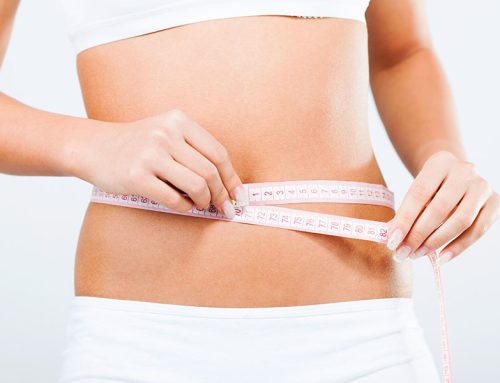

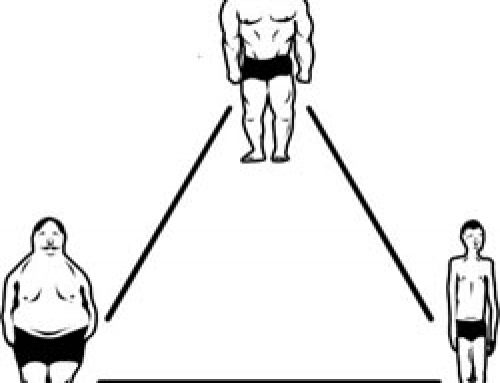
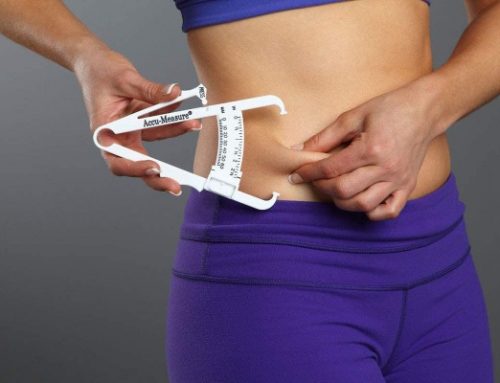
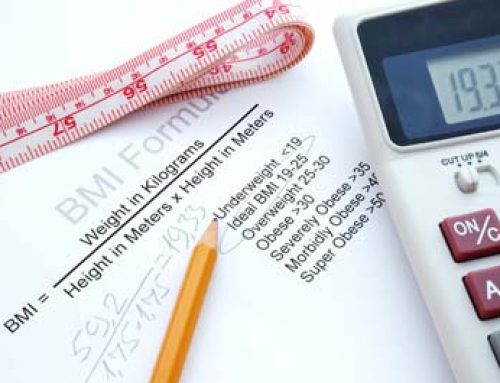
Great info Tom! Just wanted to point out that a lot of people want to lose weight (fat) at home and it’s good to know that not only can you do the workouts at home, it’s also good to know that you don’t have to pay a trainer and a gym if you don’t want to. You can use those fat testing tools mentioned in the post to check the results of your work every week. However, depending on what those results say, we may we may find it hard to continue sometimes, if the results are not to our liking. as you always say, its just feedback, and you have to keep going. Weight (fat) loss takes time and patience.
I’ve found that using the Accumeasure is pretty accurate when compared to the hydrostatic testing method. For me, I was about 3% too high when using the calipers so getting a more accurate test to verify made me feel even better! But with practice, it’s good enough and as long as you are tracking your progress (margin of error or not) it will do wonders for your mental and physical progress. I’ve had months where I’ll track nothing and while I stay roughly the same, it’s self defeating as a bodybuilder who wants to constantly improve. Plus the Accumeasure is simple and affordable. Hard to beat that!
I was wondering about the effectiveness of calipers on people who have lost a lot of weight. Over almost the last 2 years I have lost nearly 100 pounds but never paid much attention to body fat percentage. I always lifted and ate plenty of protein and avoided intense calorie shortages for the most part but I only watched the scale, mirror and clothes sizes. After purchasing (and beginning to read) BFFM I have decided to give body fat percentage measuring a shot… but I worry that the fact that I have quite a bit of loose/extra skin leftover from my heavier weight may have an effect on my readings. Am I better off using a BIA machine despite their unreliability in regards to consistency? Any help is appreciated.